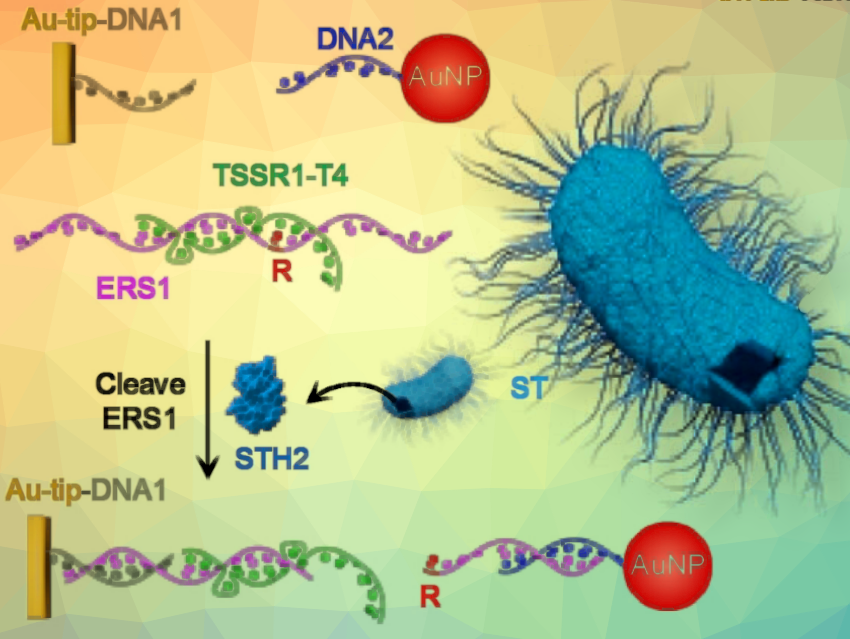Carlos D. M. Filipe, Tohid F. Didar, Yingfu Li, and colleagues, McMaster University, Hamilton, ON, Canada, have developed an easy-to-use colorimetric assay for the detection of food contaminated with salmonella. The assay is based on a novel nucleic acid probe that is cleaved by an RNase enzyme specific to the salmonella species. This specific enzymatic cleavage principle made it possible to build a sensitive but simple and portable test system using colloidal gold.
DNA-RNA Hybrid Probe
Consumption of food contaminated with Salmonella typhimurium, whether eggs, ground meat, or chicken, can lead to severe food poisoning. However, suspected cases of salmonella are usually only confirmed several days later, when the bacteria are detected in microbiology laboratories by growing them in culture. The team has developed a test system based on a hybrid DNA-RNA probe that specifically and rapidly detects salmonella, without the need for microbiological diagnostics or expensive analytical equipment.
Using a multi-round selection process, the team identified an artificial DNA-RNA hybrid probe that serves as a substrate for a salmonella-specific form of an RNase H2 enzyme. Based on this highly specific enzymatic recognition, the team first developed a salmonella RNase H2 fluorescence-based assay, and then extended the principle to a simple, portable salmonella assay using colloidal gold colorimetry.
Au-on-Au Tip Sensor
Colloidal gold is a commonly used color reagent, often seen in SARS-CoV-2 antigen test strips. However, the research team took a slightly different approach to the methodology. The team did not use a paper strip as the basis for their assay, but instead turned to plastic pipette tips, which are commonly used in the laboratory to measure specific amounts of liquids.
To prepare the colorimetric assay, the inner wall of a pipette tip was first coated with DNA-functionalized nanogold. A mixture of reagents, composed of nanogold-DNA and the DNA-RNA probe, was then drawn up into the pipette tip, creating a double layer of nanogold on the walls. This was made possible as the DNA-RNA hybrid probe linked both layers.
Salmonella Detection
However, when the sample mixture contains salmonella, the upper layer is released thanks to the salmonella RNase H2 specifically cleaving the DNA-RNA linker probe. When the gold-containing solution is then drained onto an absorbent pad with a nylon membrane, a clear red spot indicates the presence of salmonella in the sample being tested.
The team tested the specificity of their system and found that it did not falsely detect the presence of other bacteria containing RNAse H2. This portable biosensor does not require any electronic, electrochemical, or optical equipment, and it delivers a detection limit of 3.2×103 CFU mL−1 for Salmonella without cell-culturing or signal amplification.
The researchers highlight that the test is not only much less complex than other methods for detecting salmonella, but also much faster. For highly sensitive detection of salmonella, only one hour of incubation in a pipette tip is required, for example, in ground beef. In the future, the team envisions developing more nucleic acid probes that can specifically detect other infectious pathogens, such as coliform bacteria like Escherichia coli.
Reference
- A Simple Colorimetric Au-on-Au Tip Sensor with a New Functional Nucleic Acid Probe for Food-borne Pathogen Salmonella typhimurium,
Jiuxing Li, Shadman Khan, Jimmy Gu, Carlos D. M. Filipe, Tohid F. Didar, Yingfu Li,
Angewandte Chemie International Edition 2023.
https://doi.org/10.1002/anie.202300828

